Table of Contents
7 Best Flower Bushes That Do Well In Shade
Some flower bushes can grow well in the shade and do not need as much sunlight. They are just not as vibrant but they are still very much alive and may have more of a scent than usual to attract pollinators.
Light is an important factor in the life of a flowering plant. It is not possible for all plants to grow in shade. Some plants need full sunlight, while others can grow well with partial light. The choice of planting a plant depends on the available light in the area where it is to be planted.
Some shade-loving plants do not need any direct sunlight to grow well. They may still require some light, but it can come from reflected light or light that filters through the leaves of surrounding trees or other objects.
If there is not enough space for a garden in that space, then it might be necessary to plant bushes that do well in shade. There are actually quite a few options when it comes to bushes that can grow just fine without a lot of sunlight.
1. Hydrangea
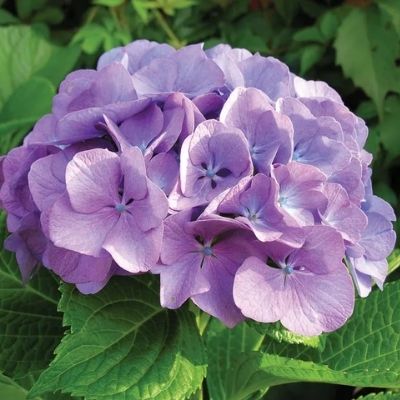
Picture of Hydrangeas
Hydrangea flower bushes grow well in the shade. They are low maintenance plants that require little fertilization, watering, or trimming and they are not as demanding on sunlight as some other plants.
The plant's leaves change colors during the season from green to deep purple, pink, or blue-green. The flower is what attracts most people to this bush because it looks like a snow-covered mountain with white snowdrifts.
This is one of the most popular species of plants too with so many different varieties growing around the world. They are either evergreen or deciduous depending on the region they are planted in.
The bloom typically begins in early spring or at the end of the fall. It all depends on the type of species, but they grow as long stems with thick bulbs or flowerheads at the end. They are known for their colorful beauty too.
These flowers do not need overwhelming sunlight to grow well. They also dehydrate easily when they are cut but the petals and leaves are larger to absorb and store water for longer.
2. Azalea
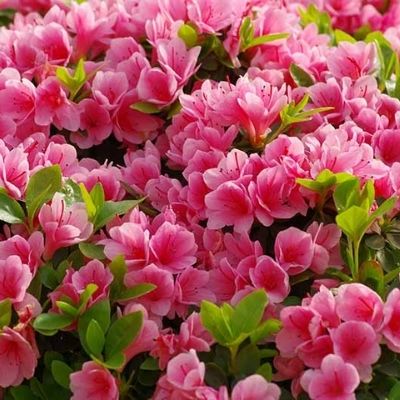
Picture of Azaleas
The azalea is a perennial flowering bush that grows well in the shade and can be placed in gardens and other areas. Azaleas grow best in moist, acidic, and loamy soils in darker areas.
Azalea flower bushes do not grow as well in constant and direct sunlight. They grow best when they receive a lot of shade and only a few hours of sunlight in acidic soil that is well-drained, or they will have trouble with their roots.
These flowers bloom in the spring between May and June when planted in the northern hemisphere. They are highly tolerant to shade and the flowers tend to last for many weeks when they are cared for properly.
The leaves and flower bulbs of this plant are extremely toxic too. Sometimes when bees feed on this plant in different regions, it produces dangerous honey that can kill them.
This is a popular flower bush in Asia and North America and it tends to be the preferred choice in many private gardens because of the pink and purple beauty the flowers can provide to improve the look of any garden.
3. Mountain Laurel
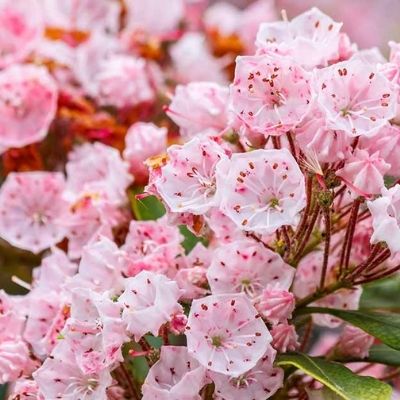
Picture of Mountain Laurels
The Mountain Laurel is a beautiful tree-like shrub that can be found in many different environments. It does well in the shade and thrives when planted with other plants because of the dark green leaves that can store energy.
It's no surprise then that it's often seen as a wilder version of the more domesticated plant known as laurel, which is cultivated for its leaves, flowers, berries, oils, and woodiness.
Mountain Laurel flowers can be found in many gardens and parks and its hardiness makes it a great garden plant. This flowering bush grows well in the shade. It is not too fussy about soil composition and can handle dry, hot periods.
It is a deciduous plant that has small, white flowers, but the colors may vary based on the species. The flowers are fragrant and bloom in late spring or early summer. The leaves are dark green and the average plant grows up to 15 feet.
The reason this flowering bush needs to be in the shade is that it can't stand heat or dryness with extended sunlight for too long. It likes moist soil, so it would grow well by the edge of darker areas.
4. Rhododendron
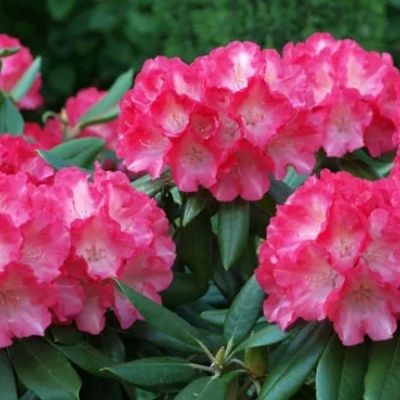
Picture of Rhododendrons
The Rhododendron flower bush grows well in the shade. The plant is an evergreen, which means that it doesn't lose its leaves during wintertime. This flower likes living in the shade because it does not have to worry about being scorched by the sun or being shaded by other plants.
The plant does well in wet soils, but it will do better if you keep the soil moist throughout the summertime. The Rhododendron bush is not very picky about soil type so you can use any type of soil as long as it is moist.
The Rhododendron flower bush is a common plant in many regions of the world. It has gained popularity because it is easy to grow, and it grows well in the shade. There are many varieties of this bush, including some that are resistant to frost or drought.
This plant has a very large family with over 1,000 different species and variants that are found around the world. It is the national flower of Nepal but continues to grow in popularity in the United States.
5. Serviceberry
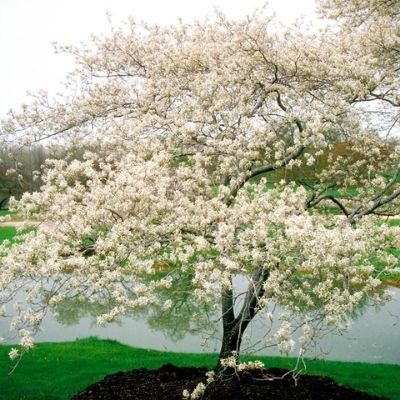
Picture of a Serviceberry Flower Bush
The Serviceberry flower bush grows well in the shade, but it can grow well in full sunlight. It does not need much water, and it requires little to no fertilizing. It is easy to plant and maintain, making it ideal for people who are new to gardening.
The serviceberry flower bush can grow up to six feet tall, but this height depends on the soil’s composition and location. When planted by a building or fence, the serviceberry flower bush will grow tall enough so that its leaves are touching the structure.
Serviceberry flower bushes are good for landscaping because they attract butterflies and hummingbirds with their vibrant red flowers during late spring through early fall. This plant is also referred to as an Amelanchier flower bush.
This is a small, but dense flowering shrub that is native to the eastern parts of North America. Its flowers are white with petals that have a very pleasant scent. This makes it a perfect option for people who want to grow a nice-smelling flower in some shade that doesn’t get too much sun.
6. Kerria
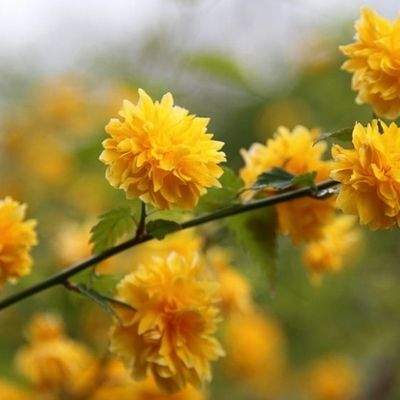
Picture of Kerrias
The Kerria flower bush or the Japanese Rose grows well in the shade. It is also known to often have golden yellow petals that are famous because of their thickness during full bloom. They can be found on mountain slopes or in gardens too.
It is one of the most popular flowering plants for gardeners who devote little space to gardening because it can survive well in even shady conditions. It is native to Asia but continues to grow with popularity in new regions of the world including the United States.
It also grows leaves alongside the flowers that are small with a length up to 10 cm long. They typically grow in sets of two or three when cultivated but lack thickness during more natural growth.
The Japanese Rose grows well in the shade. It is usually grown in the shade because it is sensitive to too much sunlight. This allows it to grow better without blanching the flowers.
7. Clethra
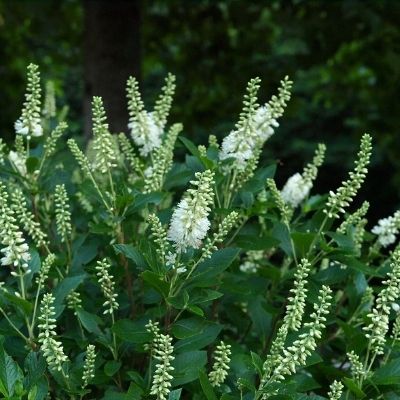
Picture of Clethras
The Clethra flowering bush is most commonly used in the landscape for its five free petal forms with attractive foliage and delicate white flowers. It is an evergreen or semi-evergreen plant that grows best in partial shade to full sun.
There are many different species and variations of this plant found around the world too. It grows well in the shade and prefers moist soils. It tolerates many different habitats too from swamps to rocky mountain regions.
Clethra plants are hardy plants that grow well in shady areas like forests or under large trees. They also grow well to the side of buildings where they can get some protection from rain and wind. The Clethra plant prefers moist soils because they do not tolerate air pollution or drought, but they tolerate frost.
How Does Shade Affect Growth of Flower Bushes?
You should take into consideration that plants are living organisms, just like humans. They have different needs and preferences, which change depending on the climate. Understanding how shade affects plant growth is very important if you are planting something in your garden.
Growers carefully place plants in the ground so that they get enough sunlight. Weeds or other plants can also grow where there is too much shade, which prevents flowering plants from growing well enough to produce fruit or seeds.
The shade of a plant can affect the plant's growth in many ways. The most obvious effect is that plants exposed to too much sunlight will grow taller than their counterparts in the shade, and they may produce more flowers and fruit as well.
Plants exposed to too little light can suffer from stunted growth and fewer flowers or fruit overall. But interestingly enough, it's not easy to keep a plant in the right amount of shade.
Some plants produce more flowers when they're left in partial shade for a few hours every day while others like the full sun all day long. It ultimately depends on the type of flower bush you are growing when determining if it needs more sunlight or shade.
Why Do Some Flower Bushes Grow Better in the Shade?
Some flower bushes use shade tolerance that allows them to grow well in the shade without any problems. This refers to a plant’s ability to still grow and remain healthy despite a low level of light exposure. Different plants have different tolerance levels, and not all plants can last long in the shade.
However, some plants grow better in shade than in the full sun. These plants tend to have larger yet thinner leaves that do not require as much light energy to enter into photosynthesis. You will also notice a color change in shade plants.
Plants that grow better in the shade will be a darker green than those that spend more time in the sun. The leaves of many plants are green because they contain chlorophyll, which is essential for photosynthesis. Chlorophyll is effective only when there is enough sunlight; if not, it will slow down or stop together.
Because of this excess amount of chlorophyll, these plants cannot handle extended light or it would destroy it. This means these plants can stay in the shade and grow healthily.
These plants rely on larger, darker green leaves and added chlorophyll to be able to grow better in the shade and store energy for longer.
Recent Articles

















